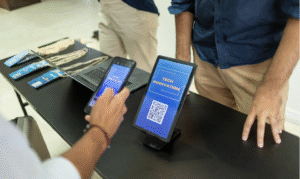
Written by: Kristen Hicks, VP of Revenue Operations at Blackthorn.io, and former Midwest College Director of Marketing and Communications.
If you’re in higher ed marketing, you’ve probably seen a flurry of emails and LinkedIn posts about tips to ramp up digital marketing and virtual events. But despite all of the webinars, blogs, etc., you’re still left wondering, “What’s working for colleges and universities? And what online efforts are keeping campus communities connected during this time?” The biggest concern is curbing the “gap year” and attrition issues institutions faced due to COVID-19.
To answer these questions, we’ve gathered recent insights from institutions and industry experts who are actually seeing ROI using digital marketing and virtual admissions event formats. To make it easy, we’ve compiled them into three key insights. Although each campus community is different, these can serve as a guide to help your admissions and marketing teams reach important institutional goals.
- Get the word out about virtual opportunities to new and existing prospects through conversational marketing.
- Cater in-person event goals and strategies to fit an online audience.
- Use virtual tools to show what makes your community unique.
Promote virtual opportunities to new and existing prospects through conversational marketing.
- Turn your website into a place for conversation, not just content. Website chatbots are helping students talk with college community members to get information fast. In a 2019 study by Drift and Survey Monkey, Salesforce found that 58% of customers said emerging technologies such as chatbots and voice assistance have changed their expectations of companies. Most bots allow companies to automate responses for common questions, or enable a live conversation if the visitor needs more assistance. Why not let your students and brand ambassadors take the chatbot wheel? Check out how Georgia State University’s success reduced summer melt after implementing its chatbot.
- Rethink your text messaging strategy. Signal Vine, a leader in smart SMS for higher education, stresses now more than ever to use text messaging to provide clear, frequent communication. Students may not have the same level of access to school counselors and other resources during closures.
- Create relevant, engaging virtual events and focus on registration-to-attendance conversion. You might sign up for a virtual webinar that piques your interest, but attending is another feat. On average, only 35-45% of registrants actually attend a webinar or virtual information session. The session information needs to be extremely relevant to your audience. The best way to get them there is to stay top of mind beforehand with timely reminder emails that hint at the helpful content you’ll be discussing. Appeal to prospects who haven™t signed up yet with a last chance to register email.

Cater in-person event goals and strategies to fit an online audience.
The end goals are the same, depending on the funnel stage engagement, application, admittance. But the strategy has changed, and so should your tactics. We all have a shorter attention span online with work-from-home distractions and constant social media notifications. Here are a few ways to keep attendees engaged.
- Break up long educational days or sessions into smaller, 15- or 30-minute chunks. Make sessions targeted for specific audiences. Parents and adults? Talk about what matters to them, such as financial aid and scholarships. High school grads? Host a live meet and greet with a student or alumni from relevant majors or extracurriculars. Cover basic program information in one session, and create flexible Q&A session in another session.
HU University of Applied Sciences Utrecht saw 9,000 prospects attend virtual events after turning an on-campus open house into a series of 400 shorter virtual sessions, trumping their in-person event attendance numbers. Why? Students who normally couldn’t come to campus due to lengthy travel could now get the same online experience, increasing the applicant pool for the upcoming semesters. Prospects attended because they were able to ask specific questions about their career paths and get answers from students, alumni, and professors.
Promote active participation. Use a meeting format instead of a webinar format so guests can easily unmute themselves or show their video. Offer up chat windows for those who are not as comfortable speaking in front of others. Are you having trouble getting participants to speak up? Our friends at Salesforce conducted an internal study to determine what types of activities create engagement in an online community. Their findings stress the importance of taking time in the beginning to spark conversation. Let everyone introduce themselves and give a fun fact.
- During the call, share links to helpful assets that provide more information or the next steps in the chat window, just as you’d pass out papers during a presentation. Be sure to include those links in your follow-up email, too.
Use virtual tools to show what makes your community unique.
- Bring the best of your community together online. For their online admissions events, the European university invited prospects to have an open discussion with professors, students, and alumni from their programs of interest instead of sending them to a pre-recorded presentation.
- Greet virtual attendees as you would on campus with a virtual handshake or an icebreaker. Show your video. Introduce yourself. Be real. Zoom meetings, as opposed to Zoom webinars, mean guests can talk instead of just typing questions in a chat window.
- Do something unique. SNHU hosts “Virtual Open Mic Nights” run by an interactive DJ to give students a non-structured place to get together and just have fun. One particular night around commencement was especially memorable as students took screenshots of themselves and their friends in their caps and gowns between songs.
- Refresh or start using virtual and live tours. Most colleges are reopening this fall, and students will eventually be returning to campus. They’ll want to know what it’s like before signing up. If possible, go mobile and let students give a live campus tour. Let them run in through Snapchat or Instagram to make it real. Don’t forget to repurpose this content on your website or for other sessions.
We’re all excited for the fall and being able to see prospective students on campus again, but you can bet virtual recruitment is here to stay. Setting up a solid foundation will help now and open up new applicant pool channels in the future that are sure to grow your prospect funnel.
Have questions about how to manage all of the logistics? Our team has helped multiple colleges and organizations move in-person events online due to COVID-19 social distancing requirements. Let’s chat about your challenges and find a solution!


